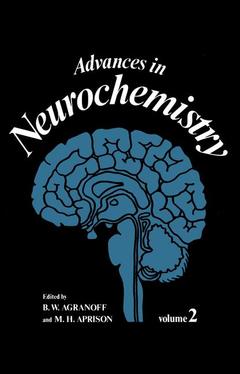Description
Advances in Neurochemistry, Softcover reprint of the original 1st ed. 1977
Cellular Organelles Series
Language: English
Subject for Advances in Neurochemistry:
Keywords
Publication date: 04-2013
346 p. · 15.2x22.9 cm · Paperback
346 p. · 15.2x22.9 cm · Paperback
Description
/li>Contents
/li>
In the Preface to Volume 1, we stated: This series recognizes that investigators who have entered neurochemistry from the biochemical tradition have a rather specialized view of the brain. Too often, interdisci plinary offerings are initially attractive but turn out to recite basic biochemical considera tions. We have come to believe that there are now sufficiently large numbers of neurochemists to support a specialized venture such as the present one. We have begun with consideration of traditional areas of neurochemistry which show considerable scientific activity. We hope they will serve the neurochemist both for general reading and for specialized information. The reader will also have the opportunity to reflect on the unbridled speculation that results from the disinhibiting effects on the author who has been invited to write a chapter. We plan occasionally also to offer reviews of areas not completely in the domain of neurochemistry which we nevertheless feel to be sufficiently timely to be called to the attention of all who use chemical principles and tools in an effort to better understand the brain. The contributions to the present volume pursue these goals. We believe the series has set high standards and has continued to uphold them. In accordance with the principle stated in the last paragraph of the Preface Volume 1, we include in this volume Koshland's "Sensory Response in Bacteria" (Chapter 5).
1 Phenylketonuria: Biochemical Mechanisms.- 1. Introduction.- 2. History of the Disease and Its General Characteristics.- 3. Elucidation of the Metabolic Block in PKU.- 4. Identification of the Affected Component of the Phenylalanine Hydroxylase System in Classical PKU.- 5. The Nature of the Genetic Defect in Classical PKU.- 6. Variants of PKU.- 7. Heterozygotes for Hyperphenylalaninemia Due to Phenylalanine Hydroxylase Deficiency.- 8. Pathogenesis.- 9. Prospects for Alternate Therapy.- 10. References.- 2 Tryptophan in the Central Nervous System: Regulation and Significance.- 1. Introduction.- 2. Peripheral Metabolism of Tryptophan.- 3. Tryptophan Transport into Cerebral Tissues.- 4. Cerebral Tryptophan.- 5. CSF Tryptophan.- 6. Tryptophan in Clinical States.- 7. References.- 3 Substance P and Sensory Transmitter.- 1. Introduction.- 2. Search for the Sensory Transmitter.- 3. The Motoneuron-Depolarizing Peptide in Dorsal Root.- 4. Distribution of Substance P in the Spinal Cord and Dorsal Root of the Cat.- 5. Isolated Spinal Cord of Newborn Rat.- 6. Lioresal.- 7. Evidence for Substance P and L-Glutamate as Sensory Transmitters.- 8. Peptides as Neurotransmitters.- 9. References.- 4 Biochemistry of Sleep.- 1. Introduction.- 2. Some Physiological Aspects of Sleep Relevant to Biochemical Changes.- 3. Changes in Cerebral Enzymes During Sleep.- 4. Carbohydrate Metabolism and Metabolic Energy of the Brain During Sleep.- 5. Nucleic Acid Metabolism.- 6. Effects of Sleep on Cerebral Amino Acids and Proteins.- 7. Neurotransmitters.- 8. Humoral Factors and the Control of the Sleep-Wakefulness Cycle.- 9. Conclusion.- 10. References.- 5 Sensory Response in Bacteria.- 1. Introduction.- 2. Methods.- 3. The Sensing Mechanism.- 4. The Receptors.- 5. The Transmission System.- 6. Motor Responses.- 7. Conclusion and Summary.- 8. References.
© 2024 LAVOISIER S.A.S.
These books may interest you

Advances in Neurochemistry 105.49 €

Pathological Neurochemistry 105.49 €

Oligodendroglia 52.74 €

